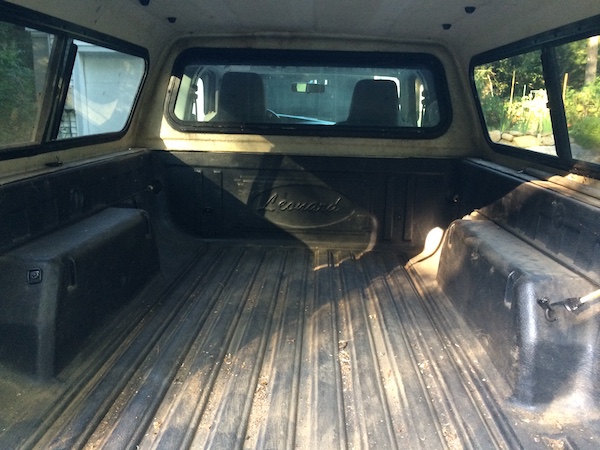Bug-Out Vehicle: Improvising A Camper

The topic of a recent Prepper Zoom Meetup was: “If you had 30 minutes notice to bug out, what would you take?” I said, my Quick Camper Kit as emergency mobile shelter. A few of the attendees wanted to see what it looked like, so here’s a look.
A few years ago, I was musing over “what-ifs” of bug out scenarios. Since the homestead, here, is already our bug-out location, there really isn’t a pre-selected destination as BOL. We’re living it now! But, if we were forced to leave, we would be more akin to refugees on our way to some improvised destination. Better to be a prepared refugee, if you’re going to be one.
We have portable emergency food we can grab, a six-gallon jerry-can of water always ready, camp cookware, sleeping bags, etc. While we have a modest pop-up tent for shelter, that would be less desirable in winter or pouring rain. My truck (an older Ford Ranger 4WD) is our BOV and can carry quite a bit under the bed cap.
But, could the covered bed work as a mobile shelter?
I carry firewood routinely in the pickup. During one sweep-out, I got to studying the little pockets molded into the sides of the bed liner. Turns out that most all pickup beds have little pockets like that so you can put 2x4s across the bed to support full sheets of plywood above the wheel wells.
What if that sheet of plywood became a temporary deck for sleeping bags?
I cut four sections of 2×4 to fit into the pockets and span the gap.
I then cut a couple strips of plywood to lay across them — a sleeping platform on both sides. I cut a shorter pieces for the middle for packing/transit, but could be lifted open for access to stored goods below the deck once ‘camped.’
To test my “prepared refugee” notion, we scheduled an overnight camping trip, packing up everything as if bugging out. In addition to our two Bug Out Bags and sleeping bags (always ready), we brought a six-gallon jerry can of water, which fit under the decking. We might not be able to source local water for filtering. We also have a supply of camping foods that require only added water (boiling or cold).
I also brought my Harbor Freight 100w solar panel set and portable battery bank (in a black Stanley toolbox, seen on the tailgate).
It occurred to me that as refugees, we might not be stopping in some remote woods where we could make a campfire from sticks to boil water. Even if we did stop in a woods, it could be during a torrential rain. (We had a night like that while bicycle camping years ago. Everything was far too wet to make a fire. That was a cold, wet, miserable evening.) We might also be ‘camped’ in some Walmart parking lot, or someplace, where a fire just won’t be practical. We would still want to boil some water for our freeze-dried camp food. We have a little Esbit stove in one of the BOBs, but a limited supply of fuel squares for it. Maybe better to have something renewable like batteries and solar.
For that possibility, I have a 12-volt “trucker’s” sauce pot which can boil water in about 10 minutes. I can (and have) powered it from the truck itself, but I wanted an option that would not drain the battery unduly or consume gasoline — which might be in short supply if we’re refugee-ing for real. Hence, my sauce pot, battery bank, and solar panels. The power set-up would also provide LED lighting at night, keep cell phones and radios powered up, etc.
The solar panels (and related gear) fit under the deck with room to spare. The battery bank traveled between the bed decks. All the other gear (BOBs, sleeping bags, clothes, food bucket, etc. rode on top of the decks.
While a little cramped for head-room, sleeping on the plywood decking was nicer than on the ground in tent. We had to crack the windows a bit to let out the excess moisture from breathing in a smaller space. Window screens kept the mosquitoes at bay. Being August, it wasn’t a cold night. If anything, we got warmer than the night air. Body heat and all. We’ll have to try the setup in cold weather to see if we’d need any heat or not. Maybe we won’t.
I did discover that my battery bank’s cigarette lighter socket had only a 10-amp fuse, so could only handle 120 Watts. My sauce pot draws 150 Watts. So, I blew a fuse. The wires were thick enough to handle more, so I was glad I had some spare fuses along.
We had a Mountain House meal for supper and made instant coffee in the morning — something to sip while the next pot of water boiled for apple-cinnamon oatmeal.
Once home, all the gear returned to their shelves and/or boxes: the decking demobilized and disassembled. All these pieces were then numbered and stored in the tractor shed, so my conversion to a camper wasn’t permanent. I’ve still got to haul firewood, after all. My truck isn’t a sole-purpose dedicated BOV. It’s still got regular work to do.
My camper conversion kit can be deployed quickly since it’s all dry-fit, requiring no tools or screws to go missing. I really hope to never need to be a refugee, but if I do, I’ve got some better (mobile) shelter than a tent.
—
